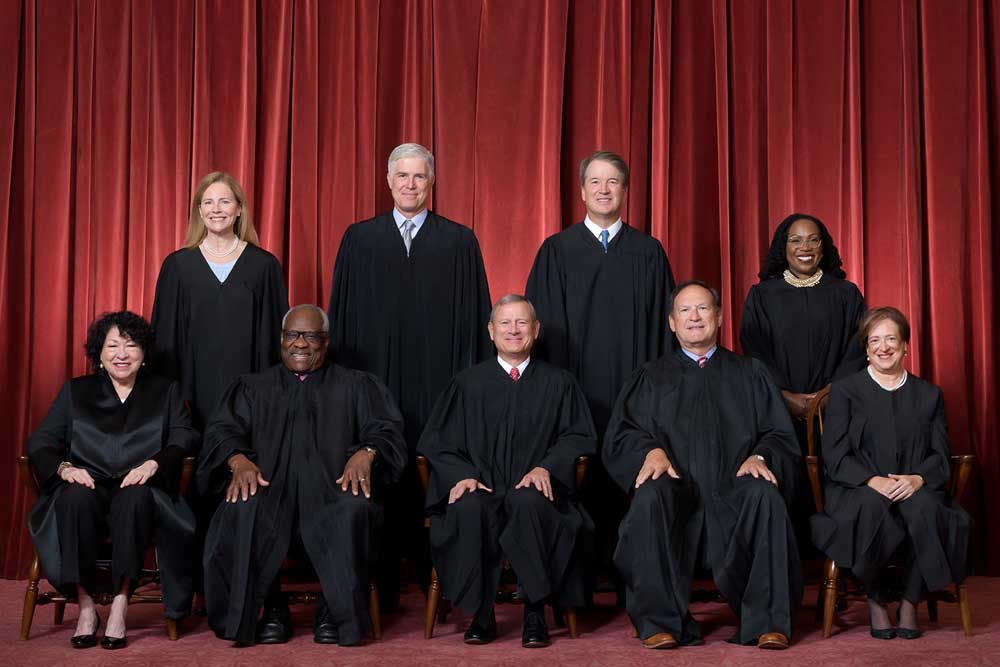Key takeaways from the Supreme Court term that upended Trump’s trial
Published 5:15 am Tuesday, July 2, 2024

- Formal group photograph of the Supreme Court in June 2022. Seated from left are Justices Sonia Sotomayor, Clarence Thomas, Chief Justice John G. Roberts Jr., and Justices Samuel A. Alito and Elena Kagan. Standing from left are Justices Amy Coney Barrett, Neil M. Gorsuch, Brett M. Kavanaugh and Ketanji Brown Jackson.
It was another momentous term — inside the Supreme Court and out.
The conservative supermajority continued to shift the law to the right, embracing an expansive view of presidential immunity favored by Donald Trump, overturning a major precedent on federal regulation long targeted by conservatives, and nixing a ban on a device to make rifles fire like machine guns that was sought by some gun rights activists.
But in other cases, the conservative shift did not go as far as it might have. The justices frequently overruled the judgments of one of the nation’s most conservative appeals courts and preserved access to the abortion drug mifepristone — for now. Cracks began to emerge among members of the right flank, highlighted by Justice Amy Coney Barrett’s occasionally sharp retorts for fellow conservatives.
It was also a term when justices made headlines that had nothing to do with the law. Controversies over flags, secret recordings and lavish travel funded by wealthy benefactors once again drew outrage and criticism, sparking a fresh push for ethics legislation in Congress.
Here are our big takeaways separate from the immunity ruling issued Monday:
Court amasses even more power
In another significant opinion, the court swept aside a 40-year-old precedent of judicial deference to agencies on certain regulatory decisions, setting up the courts as the final arbiter across a wide swath of rules affecting everything from the environment to drugs to the workplace. The move fulfilled a longtime goal of conservatives and business interests suspicious of regulation.
And the justices didn’t stop there.
They put on hold an ambitious Environmental Protection Agency program to regulate pollution that drifts across state lines, struck down the use of in-house tribunals by the Securities and Exchange Commission to decide securities fraud cases and overruled the Bureau of Alcohol, Tobacco and Firearms’s ban on bump stock devices that allow rifles to fire at rates approaching automatic weapons.
The only break from the trend came when the court upheld the funding mechanism for the Consumer Financial Protection Bureau. But overall, an already emboldened court took even more power from the executive branch.
The lurch to the right has limits
The U.S. Court of Appeals for the 5th Circuit had an outsize influence on the cases and controversies that reached the Supreme Court this term. Nine of the 62 cases came from the 5th Circuit, which covers Texas, Louisiana and Mississippi and is stacked with young, conservative Trump nominees, many of whom would likely be in contention to fill a vacancy on the Supreme Court should he be reelected in November.
The high court overturned or remanded seven of those nine decisions.
In two gun cases, the 5th Circuit wound up batting .500. The justices overwhelmingly upheld a federal law that disarms people subject to domestic violence restraining orders, reversing one 5th Circuit decision. But the justices ruled 6-3 that the 5th Circuit was correct to overturn a Trump-era regulation banning bump stock devices.
On abortion medication, the court said the 5th Circuit should not have allowed a group of antiabortion doctors to challenge access to mifepristone because the doctors were not directly harmed by the medication. Similarly, the court reversed the 5th Circuit ruling that would have strictly limited White House contacts with social media companies to flag what the government considers misinformation.
The appeals court’s record was divided, too, on cases involving the power of the executive branch. Justice Clarence Thomas wrote the 7-2 opinion reversing a 5th Circuit ruling that would have undermined the Consumer Financial Protection Bureau. But in a separate case, the court upheld the 5th Circuit’s finding that the Securities and Exchange Commission’s use of in-house legal proceedings is unconstitutional.
The justices punted on some major cases
Would the Supreme Court limit access to a widely used abortion pill? Does federal law require hospitals in Idaho to perform emergency abortions to stabilize patients despite a state ban on the procedure? Did the Biden administration or popular sites like Facebook censor conservatives using social media?
They were some of the biggest questions before the high court. In each instance, the justices essentially punted and did not reach a decision on the substance of the cases.
The justices upheld access to mifepristone for now because it ruled the plaintiffs did not have standing to bring the case. They required Idaho hospitals to provide emergency abortions while litigation plays out in a lower court, but did not rule on the merits there either.
The court tossed out an effort to prohibit government agencies from asking social media platforms to take down content seen as dangerously misleading, finding that two states and five social media users hadn’t demonstrated they were actually harmed by the Biden administration, a necessary element of any lawsuit.
The justices also returned to lower courts cases involving Texas and Florida laws pushed by conservatives, which aimed to combat claimed censorship of their views by social media sites.
The issues are hardly dead. Three Republican-led states could revive the challenge to the abortion pill. The litigation in Idaho case continues and could reach the high court again. The cases over the Texas and Florida social media laws are also ongoing and could wend their way back to the court as well.
In short, the court could soon have another bite at these apples.








